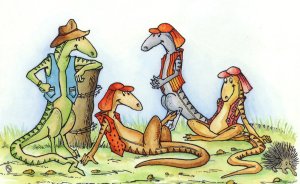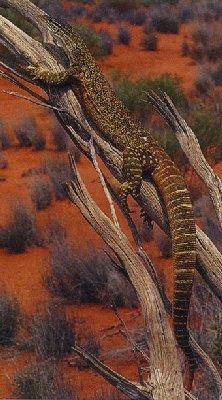The Goanna's Feature Page On
The Goanna
(Reptile - Lizard)
I'm not an expert but a little research and local knowledge go a long way.. :)
Depending on the actual type of goanna, they can be quite small, and ranging up to over 2 meters in length, and are generally a timid creature.
They eat all sorts of things and are pretty good scavengers. Their diet includes carrion, rats, mice, they like eggs, smaller reptiles, small birds, and insects. Yum.. :)
Goannas can be used for meat, oil and skins. The oil is used for therapeutic purposes and the skin makes excellent leather.
They are harmless to humans, an indeed to anything much bigger than themselves.
That brings me to another interesting point about the timidity of the Goanna. When frightened they will run to, and climb the nearest tree.. They are excellent climbers, and also very fast.
Now this takes me back to the time some friends and I were out shooting rabbits with a couple of dogs for company.. we, but mainly the dogs disturbed a smallish goanna, and of he went searching for a tree to climb.. 2 dogs in hot
pursuit... He saw me!! You could say I was in the path of
THE GOANNA'S RETREAT.
Hmmm... Sounds like a homepage I know off!!
Before I knew it I had been climbed and had a very scared goanna wrapped around my head.. and believe me those claws are sharp!!.. I had been treed by the goanna!!
My friends knocked me over flat on the ground and away ran the goanna, and up a real tree..
So if you see a goanna heading your way flat out.. just hit the deck.. it will find something else to climb.. :)
"Giddy Goanna" was the star attraction in the
Australian Governments Farm Safe Campaign as he (green character) tried to
educate his careless cousins in farm safety matters.. this was a highly
successful campaign launched through rural schools.

In our area of the northern portion of South Australia the Gould's Goanna is the predominant
species.. and you will see quite a few of them over the summer months.
Despite being timid Goanna's can actually become quite friendly if you put food
scraps out for them. It is not encouraged to try and tame them or cultivate their affection as they become easy prey for dogs and cats. They are known to raid rubbish bins as well.
The goanna leaves a very distinct track in the ground and the Aboriginal people use these tracks to find and hunt goanna's for food. They throw the dead lizard into the fire and wait until the skin begins to peel before eating it.
Enough of the preamble.. below you will find all about Goanna's or Monitors as they are
officially known. There is a specific section on the Gould's Goanna, as this is the main type found in this area. I hope the information is
useful to you.
*Monitor Facts
vah-rah'-nid-ee: "Varanus-family", after a genus of monitors)
vah-rah'-nus: "monitor", see explanation below
Varanus is a Latinisation of the Arabic name, Waran, given to a large lizard from the Arabian Peninsula. Being reputed to give warning of the presence of crocodiles, they became known in English as the monitors or monitor-lizards. The characteristics of the genus are those of the family.
These lizards, known as monitors or goannas, occur in Africa, India, South-west Asia, South-east Asia, Melanesia and Australia (which has 26 of the world's 30-odd species). Adult length varies from 20cm to three metres, the largest living species being the very bulky Komodo "Dragon" which is restricted to the Indonesian island of that name and other nearby small islands. In eastern Australia, the relatively large Lace Monitor sometimes scavenges around forest picnic site bins and barbecues.
Varanids are active diurnal hunters which stalk, run down or dig out their animal prey: smaller species take larger insects, spiders and small frogs, lizards and snakes; larger species hunt lizards, snakes, small birds and mammals but also feed on carrion. The few species that live in and near water, feed on aquatic or intertidal animals including fishes and crustaceans, but no varanid eats vegetable matter. Some species that inhabit places with marked seasonal variation in food availability remain inactive in deep refuges for several months in the year.
The eyes are well developed but relatively small; the pupil is round and the upper and lower brow folds are well developed in the smaller terrestrial desert species. The scales are small and non-overlapping, and the body colour does not change noticeably during the day. The tongue is long, narrow and deeply forked with two long-tapering points. It is flicked in and out to pick up scent particles which are taken back by the tongue tips into the olfactory Jacobson's organ in the anterior roof of the mouth. Thus there can be a significant delay between collecting a danger scent and reacting to the danger source.
Powerful limbs enable goannas to be fast runners, and agile climbers. Some species inhabit tree hollows and rock outcrops and forage both on elevated and ground surfaces; many are restricted to the ground, where they dig shelter burrows in soil or under rocks or logs.
Goannas warm themselves in the morning by basking in a sunny sheltered refuge (hollow, depression or crevice) and they shed excess heat by seeking out deep shade, elevated shaded perch sites or deep, cool burrows.
The tail is unusually long and can be lashed like a whip at a predator, rival or molester. It also acts as a counterbalance during fast running or as an extra support when standing up on the hind limbs to look about or during combats between rivals. The distal part of the tail can be broken off but does not regenerate. The males of some species differ from females in having a slightly larger tail and hind limbs. Hearing is well developed; there is a distinct external ear aperture but no vocalisation (other than hissing) is known.
During the mating season, males may engage in combat. There is no courtship display, a male simply follows a receptive female, sometimes for days, during which period they mate several times. The female buries her two to twelve eggs in a chamber dug under a stone, log, soil bank, termite mound or deep into sand. The hatchlings are very secretive.
An Australian fossil goanna, Megalania, dating from the Miocene (5-25 million years ago) was larger than the living Komodo "Dragon". Varanid fossils from the Upper Cretaceous (65-95 million years ago), have been found in North America, but no members of the family now occur in the Americas.
Gould's Goanna sunning itself up a tree.
Country is typical to this area of Northern South Australia
*Gould's Goanna Facts
Varanus gouldii (gule'-dee-ee: "Gould's monitor", or "Gould's goanna" or "Sand monitor" after John Gould, British naturalist)
The Sand Monitor is the most widespread monitor in Australia and is known by many other local names such as Racehorse Goanna and Bungarra. It is largely terrestrial and digs its own burrow system but it will readily take refuge in a tree if a burrow is not nearby.
A more yellow-coloured subspecies V.g. flavirufus occurs in northern Australia and the arid zone. It is an active forager which tracks down and digs out lizards (and their eggs), insects, spiders, scorpions, centipedes and even small
mammals (a).
Carrion is taken when available and both freshwater and marine turtle eggs may be dug up. In northern Australia it is active throughout the year; in the south, it is inactive in the cooler months.
In northern Australia it breeds in the wet season (summer); in the south mating occurs in spring. From three to 11 eggs are laid into a long deep nest-burrow which is plugged and concealed by the female. Hatchlings are seen in mid to late summer and captive incubation of eggs (at about 30 degrees C) has taken from 169 to 265 days. This indicates that the eggs over-winter and that young emerge in the following spring.
*Technical Details
Latin Name: Varanus gouldii
Class: Reptilia
Order: Squamata
Suborder: Sauria
Family: Varanidae
Genus: Varanus
Habitat: woodland, shrubland and grassland growing on sandy soils over most of the continent
Head and Body Length: to 65.5cm
Total Overall Length: to 160cm
Distribution: more than 1 million square kilometres
Abundance: sparse to common
Status: secure
*Taken From: Webster's Reptiles and Frogs of Australia. Published by Webster Publishing, 1998. Copyright Webster Publishing, and/or contributors.
|



